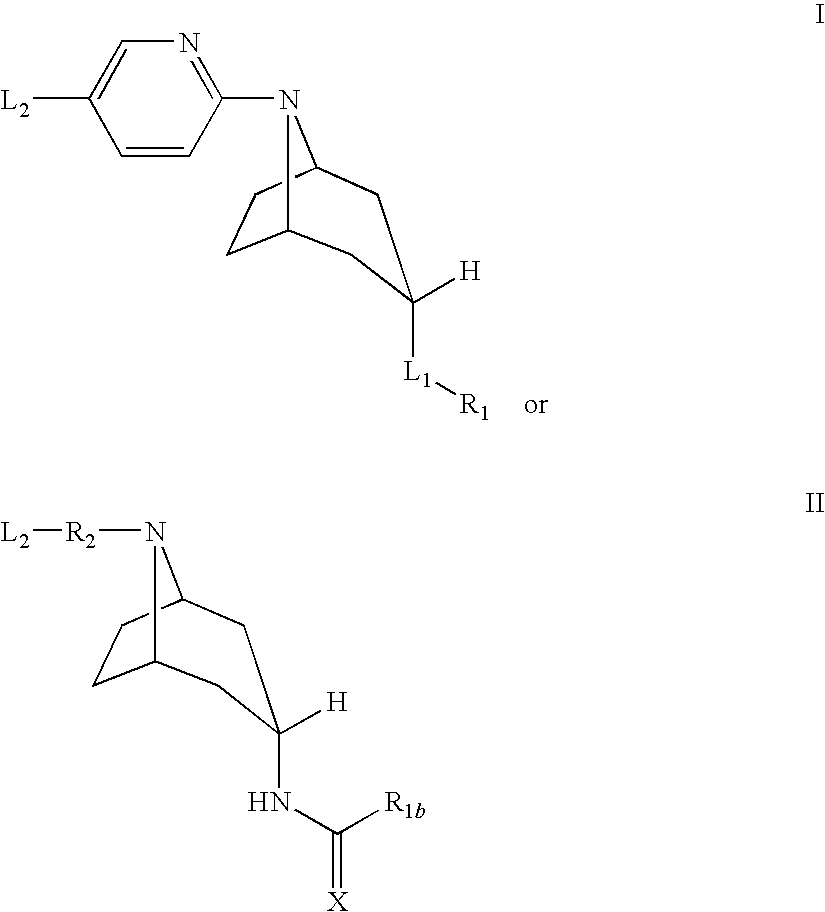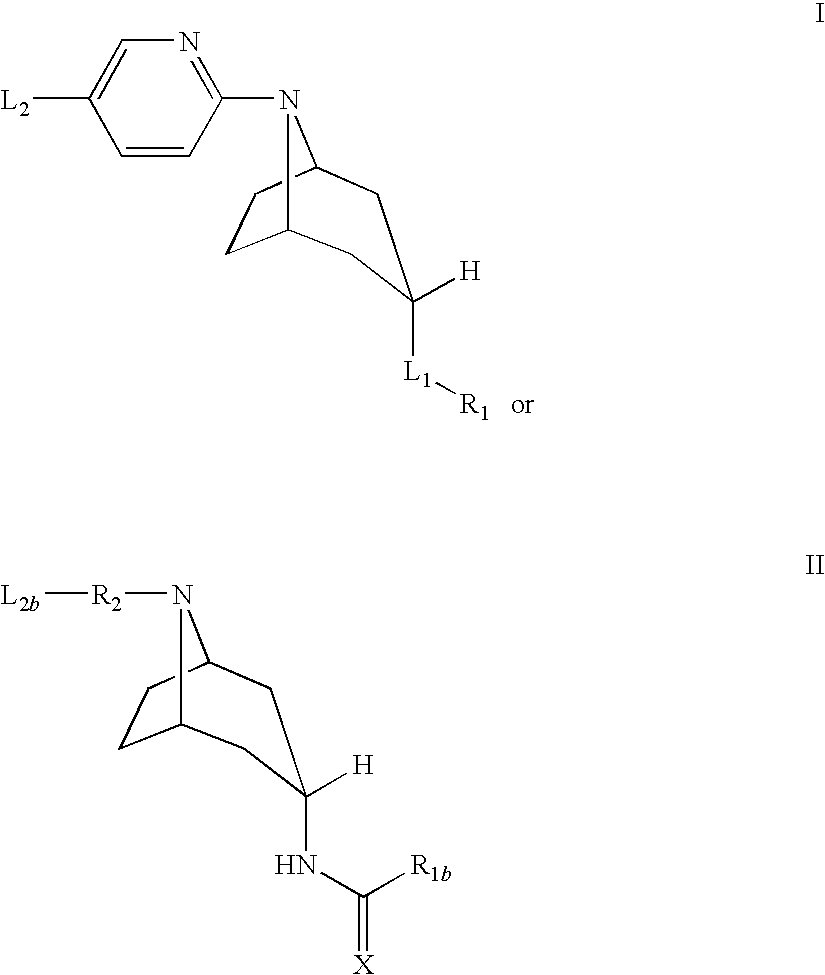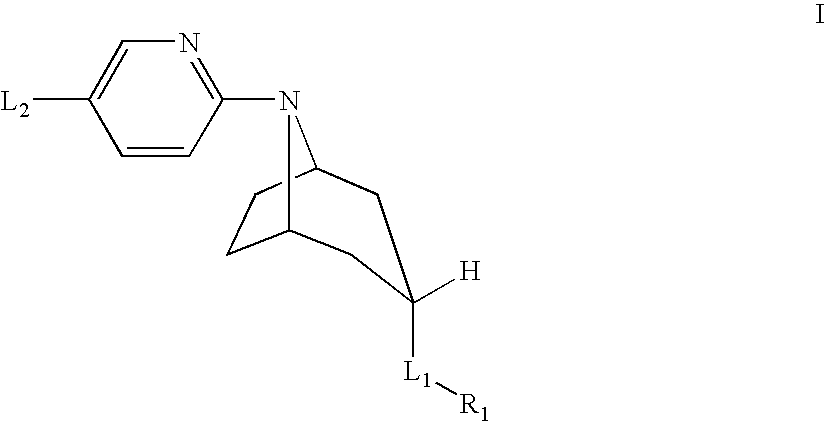Tropane compounds
a technology of tetracycline and compound, applied in the field of tetracycline compounds, can solve the problems of poor prognosis of breast cancer, frequent upregulation of hsp90 expression and activity,
- Summary
- Abstract
- Description
- Claims
- Application Information
AI Technical Summary
Benefits of technology
Problems solved by technology
Method used
Image
Examples
example 1
6-[3-endo-({[2-methyl-3-(methyloxy)phenyl]carbonyl}amino)-8-azabicyclo[3.2.1]oct-8-yl]-N-({4-[4-(2-methylpropyl)piperazin-1-yl]phenyl}methyl)pyridine-3-carboxamide
[0419]STEP 1: 1,1-Dimethylethyl 8-azabicyclo[3.2.1]oct-3-endo-ylcarbamate hydrochloride (synthesized according to the method of reagent preparation 1) (10.44 g, 40 mmol), ethyl 6-chloronicotinate (7.4 g, 40 mmol) and triethylamine (22.4 mL, 160 mmol) were added to 1,2-dimethoxyethane (40 mL) and the resulting suspension was heated at 125° C. for 24 hours in a sealed tube vessel. On cooling to room temperature, the mixture was diluted with ethyl acetate (200 mL) then washed with water (200 mL). The organic layer was washed twice with 10% aqueous citric acid (2×100 mL), brine then dried over anhydrous sodium sulfate. Filtration and concentration afforded a solid residue that was then suspended in ethyl ether. The solid was collected by filtration then washed with additional ethyl ether to give ethyl 6-[3-endo-({[(1,1-dimethy...
example 2
6-[3-endo-({[2-methyl-3-(methyloxy)phenyl]carbonyl}-amino)-8-azabicyclo[3.2.1]oct-8-yl]-N-(phenylmethyl)pyridine-3-carboxamide
[0589]STEP 1: A mixture of ethyl 6-[3-endo-({[(1,1-dimethylethyl)oxy]carbonyl}-amino)-8-azabicyclo[3.2.1]oct-8-yl]pyridine-3-carboxylate (prepared in example 1) (13.56 g, 36.12 mmol) and potassium hydroxide (4.05 g, 72.23 mmol) in methanol (120 mL) and water (40 mL) was stirred at 70° C. for 1 h. The reaction mixture was concentrated and then acidified to pH5 with 1N aqueous hydrochloric acid. The precipitate was collected by filtration, washed with water and dried to give 6-[3-endo-({[(1,1-dimethylethyl)oxy]carbonyl}amino)-8-azabicyclo[3.2.1]oct-8-yl]pyridine-3-carboxylic acid (11.69 g, 93% yield). 1H NMR (400 MHz, d6-DMSO): δ 12.46 (br s, 1H), 8.61 (d, 1H), 7.89 (dd, 1H), 6.90 (br s, 1H), 6.71 (d, 1H), 4.52 (br s, 2H), 3.44 (m, 1H), 2.12 (m, 2H), 1.94 (m, 4H), 1.75 (d, 2H), 1.39 (s, 9H); MS (EI) for C18H25N3O4: 348 (MH+).
[0590]STEP 2: A mixture of 6-[3-endo...
example 3
6-[3-endo-({[2-fluoro-3-(methyloxy)phenyl]carbonyl}amino)-8-azabicyclo[3.2.1]oct-8-yl]pyridine-3-carboxamide
[0641]STEP 1: To 6-(3-endo-(tert-butoxycarbonylamino)-8-azabicyclo[3.2.1]octan-8-yl)nicotinic acid (prepared in example 2) (4.43 g, 12.8 mmol) in THF (100 ml) was added triethylamine (2.69 ml, 19.2 mmol) and isobutyl chloroformate (1.67 ml, 13.4 mmol). The mixture was stirred at 0° C. for 1 hour, at which time a 28% solution of concentrated aqueous ammonia (20 ml) was added. The reaction mixture was stirred for 3 hours then the volume was reduced in vacuo. The resultant mixture was diluted with water and extracted with ethyl acetate. The organic layer was dried over anhydrous sodium sulfate, filtered, concentrated in vacuo to afford (1.85 g, 42% yield) of tert-butyl 8-(5-carbamoylpyridin-2-yl)-8-azabicyclo[3.2.1]octan-3-endo-ylcarbamate, which was used without further purification. 1H NMR (400 MHz, DMSO-d6): 8.60 (s, 1H), 7.94-7.88 (d, 1H), 7.71 (s, 1H), 7.09 (s, 1H), 6.86 (s,...
PUM
 Login to View More
Login to View More Abstract
Description
Claims
Application Information
 Login to View More
Login to View More - R&D
- Intellectual Property
- Life Sciences
- Materials
- Tech Scout
- Unparalleled Data Quality
- Higher Quality Content
- 60% Fewer Hallucinations
Browse by: Latest US Patents, China's latest patents, Technical Efficacy Thesaurus, Application Domain, Technology Topic, Popular Technical Reports.
© 2025 PatSnap. All rights reserved.Legal|Privacy policy|Modern Slavery Act Transparency Statement|Sitemap|About US| Contact US: help@patsnap.com



